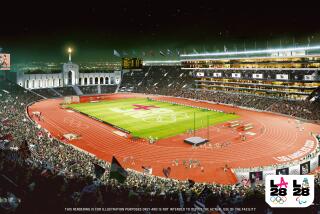Coliseum Officials Consider Further Tests on Press Box
- Share via
Reacting to the revelation that final approval of the press box at the Los Angeles Memorial Coliseum was based partly on questionable documentation, officials have directed engineers to estimate how costly it would be to do further tests on the structure.
The engineers, from the firm of John A. Martin & Associates Inc., are assessing the prospect of testing the structure’s seven “box” columns, according to Coliseum General Manager Patrick T. Lynch.
“We’re going to do whatever it is we have to do to ensure that it’s safe,” Lynch said Thursday, adding that he does not yet know what the cost would be.
In another development, William Garay, a representative of the inspector general of the Federal Emergency Management Agency, which paid for nearly all of the press-box construction, said his staff “in all probability” will open an audit of the project.
And Los Angeles County Supervisor Zev Yaroslavsky, a member of the Coliseum Commission, said he will urge his colleagues at the panel’s next meeting to order the testing of the box columns, which provide crucial support for the press box.
Citing interviews and newly obtained records, The Times reported last week that the columns were not examined with ultrasound, as claimed by a document submitted in August 1996 by the inspection firm of Smith-Emery.
Spanning 40 yards and hanging out over more than 600 spectator seats, the press box is used year-round at the Coliseum for activities including concerts, soccer matches and college football games.
The inspector whose name appears on the document, Mark Hughart, told The Times that he did not test any of the box columns that were shipped from a steel shop in San Bernardino. Hughart, who left Smith-Emery in late 1995 in good standing, said he tested only welds that were made in his presence by workers at the Coliseum. The president of Smith-Emery, James E. Partridge, said he was “not certain” who at his firm submitted the document to the project’s engineers, Nabih Youssef & Associates, two months ago.
Citing the document, Youssef on Aug. 28 dropped his long-standing concern about “several” of the box columns. On Sept. 3, Youssef formally certified that the press box was built in conformity with his design.
The inspection document, dated July 21, 1995, was never submitted to city building officials during or after the construction of the press box, according to Russell E. Lane, inspection chief.
The city now is depending on Youssef to decide whether the engineer’s certification of the structure should be withdrawn, according to Lane.
“Mr. Youssef now has a problem,” Lane said. “If Mr. Youssef feels that his certification isn’t valid, then he needs to tell us. . . . If he chooses not to [withdraw or question the certification], then he is still accepting the situation.”
Youssef has not returned calls over the last week from The Times regarding the inspection of the columns and did not respond to questions submitted in writing.
Over the last five months Youssef has said that he thinks the press box is safe, but he has also given the Coliseum Commission differing opinions regarding whether any of the columns should be tested. The condition of three of the vertical box columns has been a matter of controversy since June, when The Times reported that numerous separations had been found in the steel at areas where plates or beams would tie in.
One of Youssef’s engineers had recommended a major repair to the columns. An inspector for Smith-Emery, Dennis Johnson, ultimately accepted the columns without the repair, but also recommended that the three columns be tested for separations once beams or plates were welded onto them at the Coliseum.
But no such testing for laminations was performed at the Coliseum, according to Hughart, who was Smith-Emery’s ultrasound inspector at the stadium.
More to Read
Sign up for Essential California
The most important California stories and recommendations in your inbox every morning.
You may occasionally receive promotional content from the Los Angeles Times.











